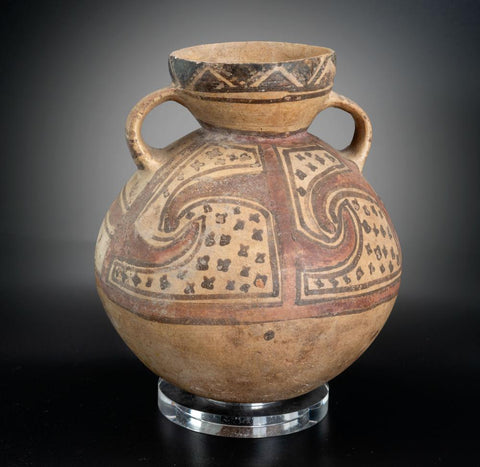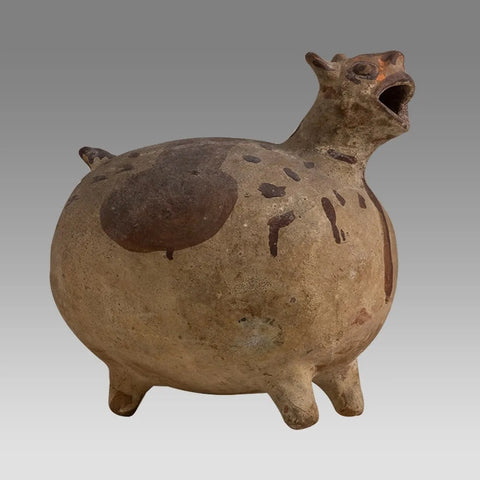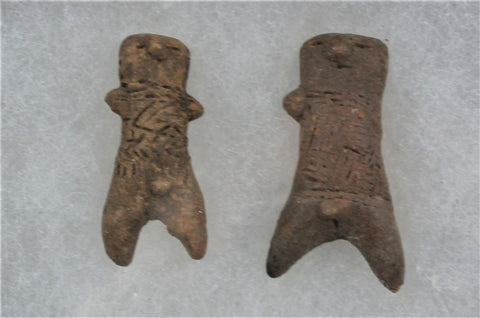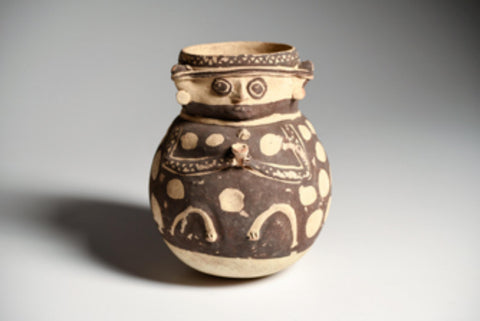Pre-Columbian, Peru Huari/Wari Culture Poly Chrome Pottery Canteen, Ca. 500 to 1000 CE, #968
$ 1,521.00
Pre-Columbian,
Peru Huari/Wari Culture
Poly Chrome Pottery Canteen, Ca. 500 to 1000 CE.
968. Description: Pre-Columbian, Peru, Huari / Wari culture, ca. 500 to 1000 CE. This is a pottery canteen with tiny twin pierced handles, presumably for suspension, and a slightly flared cylindrical spout. The body is painted an orangery-red, with darker red, cream, and black decoration in the form of mythical marine creatures with long arms. Some researchers have seen echoes of architectural decoration in Huari ceramics (like those chevrons), so this may have been inspired by the walls of a temple!
Size: 7.25" W x 9.75" H (18.4 cm x 24.8 cm)
Condition: Excellent condition. Intact with bright colors.
Provenance: Ex-California Museum of Ancient Art, Santa Monica, CA
All items legal to buy/sell under U.S. Statute covering cultural patrimony Code 2600, CHAPTER 14, and are guaranteed to be as described or your money back.
The Wari (Spanish: Huari) were a Middle Horizon civilization that flourished in the south-central Andes and coastal area of modern-day Peru, from about AD 500 to 1000. (The Wari culture is not to be confused with the modern ethnic group and language known as Wari', with which it has no known link.)
The Wari (Spanish: Huari) were a Middle Horizon civilization that flourished in the south-central Andes and coastal area of modern-day Peru, from about AD 500 to 1000.[1] (The Wari culture is not to be confused with the modern ethnic group and language known as Wari', with which it has no known link.)
Wari, as the former capital city was called, is located 11 km (6.8 mi) north-east of the modern city of Ayacucho, Peru. This city was the center of a civilization that covered much of the highlands and coast of modern Peru. The best-preserved remnants, beside the Wari Ruins, are the recently discovered Northern Wari ruins near the city of Chiclayo, and Cerro Baul in Moquegua. Also well-known are the Wari ruins of Pikillaqta ("Flea Town"), a short distance south-east of Cuzco en route to Lake Titicaca.
History
Early on, the Wari expanded their territory to include the ancient oracle center of Pachacamac, though it seems to have remained largely autonomous. Later the Wari became dominant in much of the territory of the earlier Moche and later Chimu cultures. The reason for this expansion has been debated; it is believed to have been driven by religious conversion, military conquest, or the spread of agricultural knowledge (specifically terrace agriculture).
As a result of centuries of drought, the Wari culture began to deteriorate around 800 A.D. Archeologists have determined that the city of Wari was dramatically depopulated by 1000 A.D., although it continued to be occupied by a small number of descendant groups. Buildings in Wari and in other government centers had doorways that were deliberately blocked up, as if the Wari intended to return, someday when the rains returned.[2] But by the time this happened, the Wari had faded from history. In the meantime, the dwindling residents of the Wari cities ceased all major construction. Archaeological evidence shows significant levels of inter-personal violence, suggesting that warfare and raiding increased amongst rival groups upon the collapse of the Wari state structure.[3] With the collapse of the Wari, the Late Intermediate Period is said to begin.
Government
Little is known about the details of the Wari administrative structure, as they did not appear to use a form of written record. But, the emphasis on homogeneous administrative architecture and evidence for significant social stratification suggests a complex socio-political hierarchy.
The discovery in early 2013 of an undisturbed royal tomb, El Castillo de Huarmey, offers new insight into the social and political influence of the Wari during this period. The variety and extent of the burial items accompanying the three royal women indicates a culture with significant material wealth and the power to dominate a significant part of northern coastal Peru for many decades.
Architecture
During its expansion period, the Wari state established architecturally distinctive administrative centers in many of its provinces. These centres are clearly different from the architecture of Tiwanaku, which is believed to have been a more federalized state by some scholars (such as John W. Janusek). Using these administrative centers, the Wari greatly influenced the surrounding countryside. They created new fields with terraced field technology and invested in construction of a major road network. Several centuries later, when the Inca began to expand their empire, they drew on both of these innovations. (Source Wikipedia)




